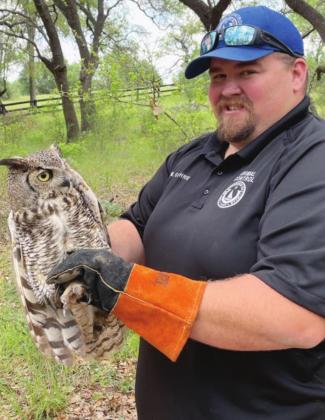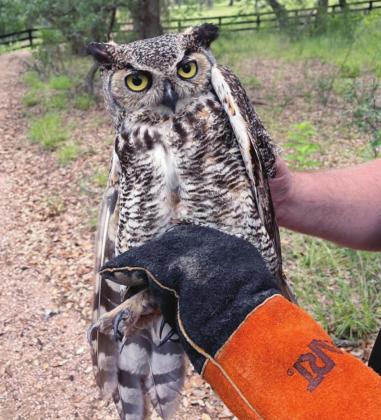A group of Horseshoe Bay residents valiantly but unsuccessfully tried to save the life of a great horned owl last week, Horseshoe Bay Police Chief Rocky Wardlow said.
It happened on Friday, May 14, when a local ladies group, known as the Texanas, were walking in The Trails subdivision, located on Ranch Road 2831. This group, led by Trails resident Judy Keller, encountered a great horned owl which had suffered an injury and was unable to fly.
Keller contacted Horseshoe Bay Police Department and animal control officer Mike Guthrie and patrol officer Martin Younger were dispatched to the scene, Wardlow said.
Guthrie and Younger were able to successfully capture the owl without causing it any further injury and contacted Texas Parks & Wildlife Department for assistance and game warden Ryan Johnson of Llano responded.
It was believed the owl had been struck by a vehicle and had suffered a broken wing as well as road rash on one leg.
The responding officers took the injured owl to Arlene Pearce, a local volunteer animal rehabilitation specialist who works with small mammals, songbirds, shorebirds, and raptors at her Heart of Texas Wildlife Rehabilitation Center at Lake Buchanan.
Pearce confirmed the owl’s wing was broken near the shoulder. Despite Pearce’s best efforts, the wing was damaged to the extent that surgery, rehabilitation, and release was not possible.
“According to Pearce, she kept the owl as comfortable as possible, but unfortunately no option was left other than euthanasia,” Wardlow said. “Pearce applauded the efforts of the officers for giving the raptor a peaceful ending.”
Great horned owls, also known as hoot owls because of their vocalization, are the most widely distributed true owl in the Americas and they are commonly found throughout the state of Texas. While they are generally nocturnal, great horned owls can be found hunting in the daytime on a cloudy day.
Owl wings rely on not only a humerus that is connected to a clavicle and scapula, but also a coracoid, a bone found only in birds, which provides the support necessary for a powerful downstroke of a beating wing. A traumatic injury can mean an owl will never fly again and thus be unable to hunt its prey to feed itself.



